Etudes et évaluation de processus océaniques par des hiérarchies ...
Etudes et évaluation de processus océaniques par des hiérarchies ...
Etudes et évaluation de processus océaniques par des hiérarchies ...
You also want an ePaper? Increase the reach of your titles
YUMPU automatically turns print PDFs into web optimized ePapers that Google loves.
187<br />
3.6. HEAT CAPACITY 13<br />
tel-00545911, version 1 - 13 Dec 2010<br />
Density <strong>de</strong>pends on temperature, salinity and pressure in a non-linear way and these non<br />
linearities lead to many interesting phenomena. The actual <strong>de</strong>pen<strong>de</strong>nce, for values typical to the<br />
ocean, is given by the UNESCO 1981 formula which is a best fit to laboratory measurements. A<br />
numerical version of this formula is implemented in all numerical mo<strong>de</strong>ls of the ocean dynamics.<br />
The non linearity of the equation of state leads to interesting and important phenomena in<br />
oceanography. One is cabbeling which means that by mixing of two water masses the resultant<br />
water mass has a <strong>de</strong>nsity which is superior than the weighted mean <strong>de</strong>nsity. As shown in fig. 3.2<br />
if the two water masses have the same <strong>de</strong>nsity their mixture, somewhere on the dashed line,<br />
has a larger <strong>de</strong>nsity.<br />
It is the difference in <strong>de</strong>nsity that is dynamically important. We have seen in section 3.2<br />
that two whuch are at different <strong>de</strong>pth might have the same temperature but different potential<br />
temperature. As it is the potential temperature that is conserved by a water mass when move<br />
adiabatically it seems more natural to measure sigma values in terms of potential temperature.<br />
To com<strong>par</strong>e <strong>de</strong>nsities of water masses oceanographers introduced the notion of potential <strong>de</strong>nsity,<br />
where σ 0 (θ,S) is the “sigma value” of a water mass of potential temperature θ and salinity<br />
S when brought adiabatically (no exchange of heat) to the sea surface. Potential <strong>de</strong>nsity is,<br />
unfortunately, not the answer to all the problems, as two water masses which have the same<br />
σ 0 might have differnt <strong>de</strong>nsities at <strong>de</strong>pth. This is again a consequence of the non-linearity<br />
in the state equation called thermobaricity which is due to the fact that warmer water is less<br />
compressible than col<strong>de</strong>r water. This can be seen in fig. 3.3 where the sigma <strong>de</strong>nsity of two<br />
water masses is given at the pressure of 0 dbar (at the surface) and at 4000 dbar. The water<br />
mass which is heavier at the surface is actually lighter at 4000 dbar. This lead to the <strong>de</strong>finition<br />
of not only the potential <strong>de</strong>nsity at the surface σ 0 but also for example to σ 4000 , which gives the<br />
sigma value of a water <strong>par</strong>cel when transported adiabatically to a pressure of 4000dbar ≈ 4000m<br />
<strong>de</strong>pth.<br />
Locally the <strong>de</strong>pen<strong>de</strong>nce can be written:<br />
ρ(T + δT,S + δS,p + δp) = ρ(T,S,p)(1 − αδT + βδS + γδp), (3.5)<br />
where α is the thermal expansion coefficient, β is the saline contraction coefficient and γ the<br />
compressibility of sea water. The non-linearity of the state equation arises from the fact that<br />
all these coefficients are themselves functions of temperature, salinity and pressure.<br />
3.6 Heat Capacity<br />
The dynamics of the ocean is important for our climate due to its transport of heat from the<br />
low to the high latitu<strong>de</strong>s. The heat capacity of sea water is around 4.0 ×10 3 J (K kg) −1 , about<br />
four times the value of air. At the sea surface air is almost 770 times less <strong>de</strong>nse than water. At<br />
equal volume water contains approximately 3000 times more heat than air.<br />
Exercise 3: Suppose that the atmosphere above the ocean has a constant temperature<br />
(in<strong>de</strong>pen<strong>de</strong>nt of height) and that the ocean un<strong>de</strong>rneath is at the same temperature. What<br />
is the <strong>de</strong>pth of the ocean if it contains the same amount of heat as the atmosphere above?<br />
(C p (seawater) = 4.0×10 3 J/(kgK) and C p (air) = 1.0×10 3 J/(kgK)). Do not use the thickness<br />
of the atmosphere in your calculations.
















